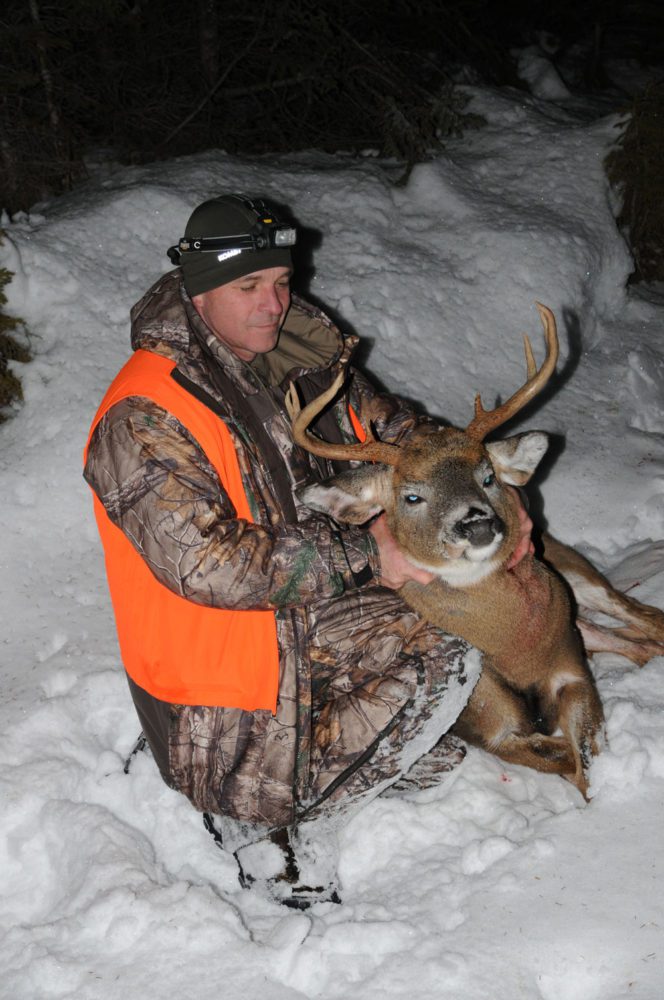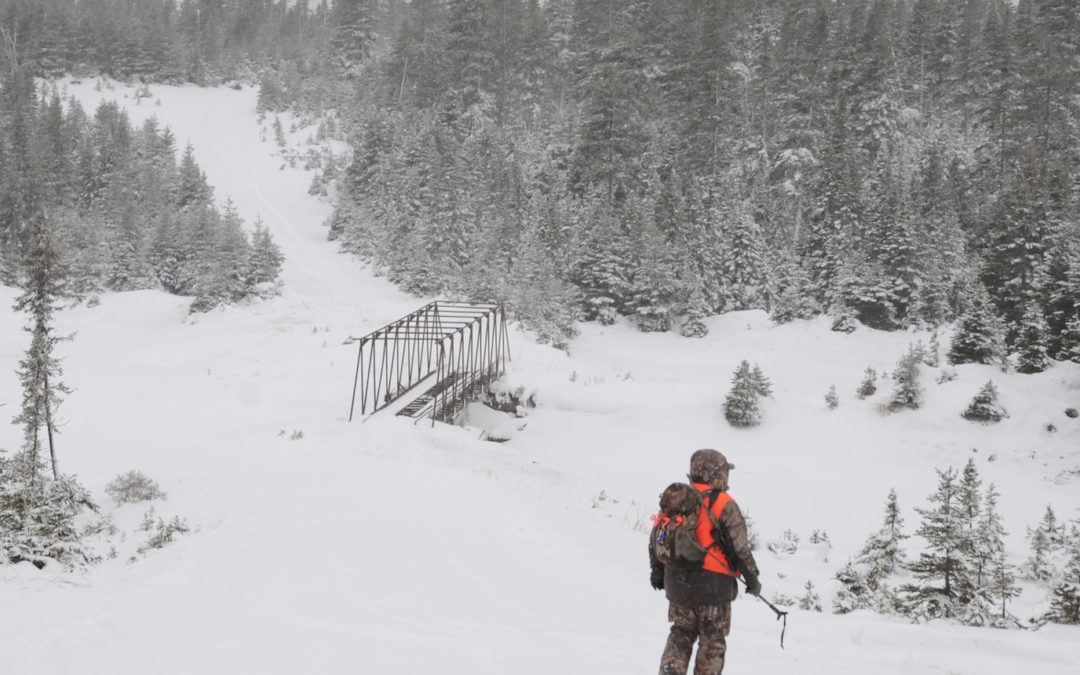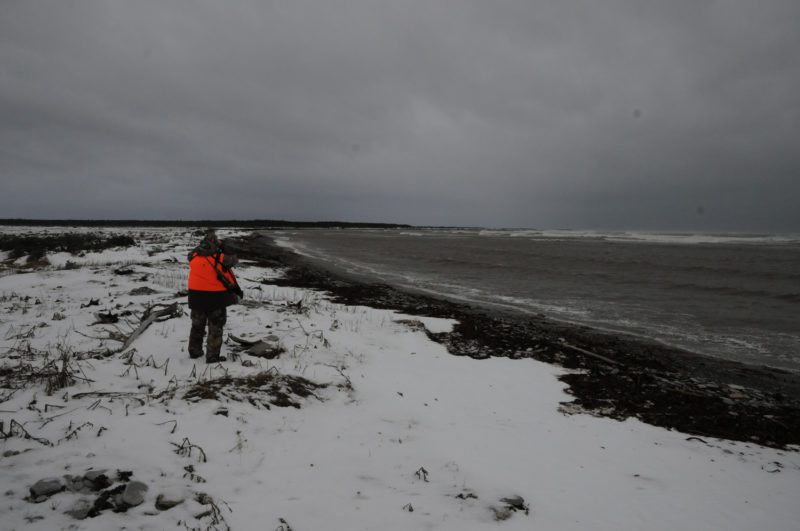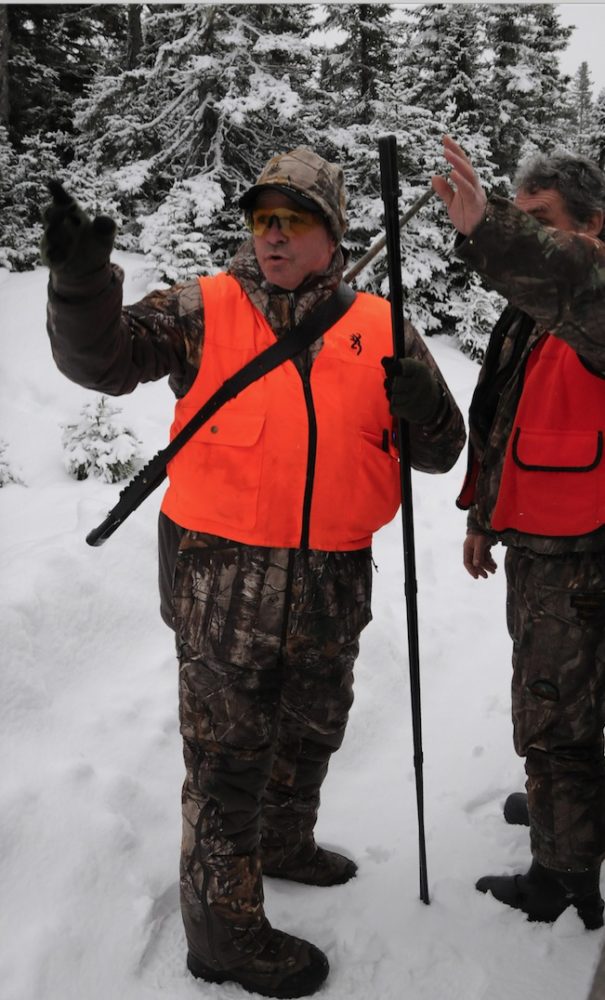The weather forecast bode ill for our motley company of 16 heavily camouflaged hunters. Temperatures were to sink well below freezing with winds clocking steadily 25 mph and gusting to twice that and more. As his pick-up with his ATV strapped in its bed jounced down rutted snow-packed road from paved landing strip I’d first known as gravel nearly 20 years ago, Dugie Stewart, head man at Safari Anticosti’s lodge on Bell River, described how the deer would likely move under conditions as howlingly bitter as these.

After a 6km hike on Anticosti’s beach, Serge Lestage felled this 8-point, 175-pound buck with a single 276-yard shot.
From sparsely wooded highlands, seldom more than 300 feet above sea level graced with large grassy bogs euphemistically called meadows now being armored against winter by layers of snow and ice, whitetails would migrate down to dense spruce forests along the narrow cobbly beach rimming the island to feed on seaweed flung ashore by fearsome waves. They would stream along trails known only to them and the handful of guides who work for Safari Anticosti, crossing myriad gravel tracks first cut by woodsmen who came to log the island after Henri Menier purchased it in 1895 for $125,000. Menier, the French chocolate magnate whose candies can still be bought like Hershey’s in stores worldwide, stocked it as his own hunting preserve with elk, whitetails, and foxes, the latter for their furs to please the fancy ladies of Paris.
Dugie and his fellow guides delivered us to Bell River camp, a collection of a dozen frame buildings arrayed on a bench 100 feet above its namesake stream. Of our group, 14 would be quartered in the main lodge. Two of us were placed nearby in a very comfortable three-bedroom cottage with two baths. My cabinmate was Serge Lestage from Baie Trinite, a village of 400 on the north shore of the Gulf of St. Lawrence about 350 miles east of Quebec City. Dugie had chosen my companion well. I was the only U.S. hunter in camp, and Serge’s English was far, far better than my meager French.
Serge and I connected on another point as well. He’d begun handloading his own ammo five years ago and could debate the relative merits of IMR 4350 vs. IMR 4064 as the optimum powder to push 165 grain Speer boattail spitzers from his Ruger M77 MK II .30/’06. Whatever our opinions, the difference proved moot when he dropped in its tracks a fine Anticosti whitetail.
For the first two days of our week together, he and I hunted with guide Patrice Larouche from his crewcab Ford 350. We prowled myriad snow packed roads webbing our sector of Anticosti like veins on the back of a gnarled hand. Patrice’s eyesight was superb. “A doe, there!” he would point as we drove along. I saw nothing. He’d stop the truck and gesture emphatically at a shape hidden in a thick stand of spruce illuminated by no more light than that of the hour before dawn no matter what time it was.
With practice, I came to be able to make out a doe’s faint white throat patch then her erect ears and finally her jet black eyes and nose. What I saw mostly were their fleeting tails. Though Patrice had told us that most good bucks were taken along the roads, by night fall of the second day we had seen nothing worth a shot.
It was obvious to me that my need for good photos and Serge’s desire to bag a great buck were incompatible. Dugie arranged for Serge to hunt alone with Michele Lambert, a decision that proved very wise. For the next two days, Serge and I went our separate ways. While he and Michelle probed the interior of our sector via four-wheeler and afoot, Patrice and I continued our fruitless quest along the roads.
At the end of the fourth and next-to-last day of our week on Anticosti, Serge returned to our cottage well after dark, burst open the door, and declared that he’d killed a very good buck. After shooting pictures and hanging it in the meat house, he told me the story over a beer.
That morning, he and Michelle planned to hunt the beach near the abandoned lighthouse beyond an old airstrip all but overgrown now with knee-high spruce. At the end of a woods road just inland from the bay, they rolled the four-wheeler out of the pickup, parked it, climbed back in the truck, and drove about 10 kilometers east and down as close as they could get to the sea. Leaving the truck, they began their hike back to the four-wheeler just above the high tide line. Waves had cut a scarp just over their heads. In grass on the flat above, they could see deer feeding sometimes in small groups of nine or so, but once in a while in groups three times that size.
As they hiked, careful not to slip on gobs of stinking seaweed, they looked up every so often. After six kilometers, Michele spotted a big deer. They looked more closely, it moved, and revealed itself to be a nice buck. But the shot was too far, “maybe 700, 800 meters”, Serge says.
“We wait, we wait,” he continues. “And we started to walk, and he was eating.
“We walk, we walk, we stop, and Michele put his tripod (spotting scope) on him and asks me ‘can you see ‘im?’
“I say ‘yes’ but he was between two trees like (Serge holds up two fingers in a “v”), and I can’t shoot.
“Then he turned around and put his head down and I shot him right in the neck and he dropped. From my Leupold, the shot was perfect.” With his GPS, Serge measured the distance at 276 meters. The buck carried a symmetrical 8-point rack with a 17-inch spread.
“And now,” Serge chuckles, “the fun part comes.” To reach the four-wheeler, they have to hike a kilometer, maybe a little more. The quad won’t start. Michele tinkers with it, finally he gets it going, and heads off to retrieve the truck. Serge hikes back to the deer and half an hour later, Michele catches up to him in the four-wheeler.
But the ground is too soft for the machine so they have to cut brush to corduroy the path. Where snow and mud is too deep even for that, they tie a rope to the buck and drag it out knee-deep step by knee-deep step. Dark has long since fallen before they reach the lodge. At the end of our week, Serge’s whitetail proves to be the largest of more than 20 hanging in the meat house.
Many of the bucks taken while we were here were, indeed, shot close to Anticosti’s roads. With no whirring feeders spreading corn, no mineral blocks or other baits, and no carefully cultivated feed plots…and with weather as fickle as only successive nor’easters can make it, hunting on this island in Canada’s Maritimes is just about as natural as it gets. And hospitality could not be more accommodating.
For more information, visit http://www.safarianticosti.com.
Safari Anticosti is one of more than 50 great places to hunt and fish that Ross profiles in Sporting Classics’ new book Classic Sporting Lodges to be released in May, just in time to arrange trips for fall.




